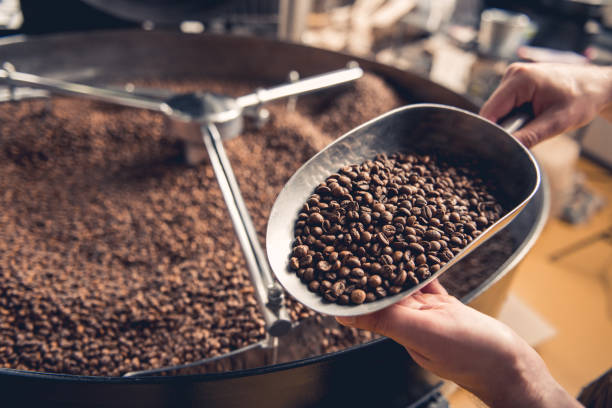What is the problem?
The HSE in the UK have issued a Safety Alert in relation to exposure to Diacetyl vapour which can cause severe and irreversible lung disease.
HSE scientific studies indicated that heating Diacetyl above certain temperatures significantly increases airborne concentrations and the potential for exposure above occupational exposure limits (OELs). Exposure could occur through use of flavourings and as a byproduct of coffee roasting.
Diacetyl also known as 2,3-Butanedione is a naturally occurring organic compound but is also manufactured synthetically. It can be generated in brewing of beers and in coffee roasting.
Diacetyl has a characteristic butter-like odour indeed it is what gives butter its flavour. It is present in many beverages such as tea, beer, wine and foods such as fruit, vegetables, fish and meats. It is used as an artificial flavouring in foods such as margarine, microwave popcorn, and cooking oils.
Diacetyl is also present in cheese, milk, whiskey, as well as roasted coffee. Until recently, artificial diacetyl was used in some processed foods to impart this flavour, and it is still applied to flavoured e-cigarettes (Caffeine Magazine: Is coffee roasting giving you lung disease?).
The OELs in the Chemical Agents and Carcinogens Code of Practice 2021 (and EH40 in the UK) are 0.02 ppm (0.07 mg/m3) 8-hour time weighted average (TWA) and 0.01 ppm (0.36 mg/m3) 15-min TWA.
The Safety, Health and Welfare at Work (Chemical Agents) Regulations, 2001 (S.I. No. 619/2001) requires employers to ensure work-related exposure is prevented, and where it is likely to occur, it should be assessed and controlled so that it is below the OELs. Safety data sheets provided by suppliers for diacetyl or mixtures containing diacetyl should outline the hazards as well as precautions to be taken.
Exposure from Coffee Roasting
Diacetyl is generated naturally during bean grinding and is temperature dependent. Exposure levels during bean roasting and grinding can exceed OELs.
Concentrations are significantly greater if the roasted beans are ground when still warm (around 40 degrees Celsius). If the beans are cooled between roasting and grinding down to room temperature (16 to 20 degrees Celsius) the concentration of Diacetyl vapour is reduced.
Carbon monoxide (CO) is also known to be a byproduct in coffee processing. Local exhaust ventilation (through enclosure and extraction) will also help control Diacetyl and CO emissions. The HSE recommends that as part of a risk assessment process
sampling is carried out to establish whether any further controls for CO may be necessary.
Risk in Flavour manufacture
Airborne concentrations of Diacetyl and the possibility of exposure to levels above occupational exposure limits are significantly increased if flavour mixtures containing Diacetyl are heated, added to hot processes or spray dried.
Risk of exposure can occur during:
- Opening of containers
- Mixing
- Spray drying to produce powders
- Packaging
- Cleaning of vessels
- Spillages
What do we need to do?:
If your processes include the use of diacetyl, if you use flavourings that contain Diacetyl or are likely to produce Diacetyl, then you must carry out a risk assessment. The risk assessment should help you to identify the hazards associated with the potential for exposure to identify who might be harmed and how and the necessary precautions to reduce or eliminate the risk.
Employers should check if diacetyl is included in the safety data sheet for the food flavouring. If Diacetyl is present, consider substituting with a safer alternative. If substitution is not an option (or diacetyl is a natural byproduct) then strict controls should be put in place as outlined below.
Examples of control measures:
- Check the Safety Data Sheet from the supplier.
- Keep flavorings below 4 degrees Celsius to prevent generation of vapours
- Enclose the process and use local exhaust ventilation or extraction to control Diacetyl vapor emissions at source.
- For coffee manufacturing cool the coffee beans to at least below 20 degrees Celsius pre-grind
- In Diacetyl flavouring manufacture and use, add the flavouring at the last stage of production and via an enclosed or automated system.
- Where the controls outlined above do not reduce exposure below the OEL you should consider providing appropriate PPE including respiratory protective equipment RPE.
Health surveillance may also be advisable if the risk assessment indicates that there is a reasonable likelihood of exposure to Diacetyl vapour.
It should be noted that most commercial coffee roasting machines are generally “closed systems” that are built to channel the natural by-products of roasting through closed pipes to exhaust stacks.
Even the “cooling carts,” where coffee beans cool after roasting (as the name implies), are designed to minimise potential exposure. A system of fans and holes in the bottom of these trays draw the air down through the beans, and then out via exhaust pipes to the outside.
However, small roasters in sheds and garages or other small batch operations may not be aware of the potential risks to themselves or their employees.



